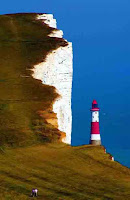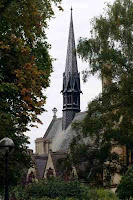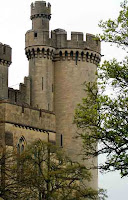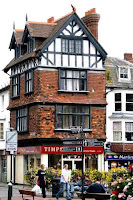Twenty years after their ancestral nest in Corfe castle had been destroyed by the Parliamentarian forces and the monarchy came back to the throne, the royalist family of Bankes instead of resurrecting their badly damaged former residence moved 19 miles to the north of Corfe castle into just having had built for them Kingston Lacy (Kingston Hall then). At that time, in the 17th century, it vaguely resembled this beautifully proportioned Italian palazzo looking house – just a humble manor made of brick.
The great transformation occurred to the house in the 19th century, when William John Bankes because of the sudden death of his older brother unexpectedly inherited the whole estate. Attractive, quick-witted (sometimes even too caustic in his comments), aesthete to the core and indefatigable traveller William was a somewhat eminent character of his generation. His close friends (such as Lord Byron) and contemporaries admired his inquisitive mind and inexhaustible fortitude that he displayed in his numerous expeditions. While travelling across Spain Bankes took fancy to Spanish art, where he showed high interest in discovering the new talents rather than in popular masters. The opulent Golden or Spanish Room in Kingston Lacy became a sheer trove of paintings of rare Spanish artists that he had accumulated there from his trips. But probably the biggest passion of William’s life was Oriental (especially Egyptian) culture. He spent a good many years roaming across the Middle East satisfying his curiosity and draw for travelling not forgetting at odd moments to bring home some of the Egyptian artefacts, such as the Philae obelisk or granite sarcophagus that still can be seen in the Kingston Lacy garden.
While travelling across Spain Bankes took fancy to Spanish art, where he showed high interest in discovering the new talents rather than in popular masters. The opulent Golden or Spanish Room in Kingston Lacy became a sheer trove of paintings of rare Spanish artists that he had accumulated there from his trips. But probably the biggest passion of William’s life was Oriental (especially Egyptian) culture. He spent a good many years roaming across the Middle East satisfying his curiosity and draw for travelling not forgetting at odd moments to bring home some of the Egyptian artefacts, such as the Philae obelisk or granite sarcophagus that still can be seen in the Kingston Lacy garden.
During one of his voyages William Bankes clicked with Sir Charles Burry, a talented architect who later would be better known for working on such projects like the restoration of Palace of Westminster or building Cliveden House in Buckinghamshire. It was Burry who brought the alterations into appearance of Kingston Lacy thus fulfilling the Bankes aesthetic dream of living in the house where everything reminds of the Renaissance. Though the renowned traveller did not manage to enjoy his cherished palazzo due to the scandal he would bring about few years later. There had already been rumours regarding Bankes unconventional sexual orientation before, but at this time it was difficult to deny his homosexuality because he reportedly was caught red handed in the public place. Even these days, when we fight for any freedom and call ourselves open minded comparing to the previous generations, there is still a good many people showing their intolerance and preconceptions regarding gays, then the Victorians seemed to be even more preconceived. So Bankes hastily fled England to Italy, where he spent the rest of his life and from where he did not cease to send some lovely peaces of art for his beloved Kingston Lacy like “Apollo crowning a Poet” by the brush of prominent Venetian painter Jacobo Robusti. It was restored and hung back to Kingston Lacy not long ago, producing vast interest in public and making researchers to rack their brains over the decipherment of the allegory depicted in it.
Permission is hereby granted to reproduce this article in its entirety as long as active link back to this web-address is included.
The great transformation occurred to the house in the 19th century, when William John Bankes because of the sudden death of his older brother unexpectedly inherited the whole estate. Attractive, quick-witted (sometimes even too caustic in his comments), aesthete to the core and indefatigable traveller William was a somewhat eminent character of his generation. His close friends (such as Lord Byron) and contemporaries admired his inquisitive mind and inexhaustible fortitude that he displayed in his numerous expeditions.
 While travelling across Spain Bankes took fancy to Spanish art, where he showed high interest in discovering the new talents rather than in popular masters. The opulent Golden or Spanish Room in Kingston Lacy became a sheer trove of paintings of rare Spanish artists that he had accumulated there from his trips. But probably the biggest passion of William’s life was Oriental (especially Egyptian) culture. He spent a good many years roaming across the Middle East satisfying his curiosity and draw for travelling not forgetting at odd moments to bring home some of the Egyptian artefacts, such as the Philae obelisk or granite sarcophagus that still can be seen in the Kingston Lacy garden.
While travelling across Spain Bankes took fancy to Spanish art, where he showed high interest in discovering the new talents rather than in popular masters. The opulent Golden or Spanish Room in Kingston Lacy became a sheer trove of paintings of rare Spanish artists that he had accumulated there from his trips. But probably the biggest passion of William’s life was Oriental (especially Egyptian) culture. He spent a good many years roaming across the Middle East satisfying his curiosity and draw for travelling not forgetting at odd moments to bring home some of the Egyptian artefacts, such as the Philae obelisk or granite sarcophagus that still can be seen in the Kingston Lacy garden.During one of his voyages William Bankes clicked with Sir Charles Burry, a talented architect who later would be better known for working on such projects like the restoration of Palace of Westminster or building Cliveden House in Buckinghamshire. It was Burry who brought the alterations into appearance of Kingston Lacy thus fulfilling the Bankes aesthetic dream of living in the house where everything reminds of the Renaissance. Though the renowned traveller did not manage to enjoy his cherished palazzo due to the scandal he would bring about few years later. There had already been rumours regarding Bankes unconventional sexual orientation before, but at this time it was difficult to deny his homosexuality because he reportedly was caught red handed in the public place. Even these days, when we fight for any freedom and call ourselves open minded comparing to the previous generations, there is still a good many people showing their intolerance and preconceptions regarding gays, then the Victorians seemed to be even more preconceived. So Bankes hastily fled England to Italy, where he spent the rest of his life and from where he did not cease to send some lovely peaces of art for his beloved Kingston Lacy like “Apollo crowning a Poet” by the brush of prominent Venetian painter Jacobo Robusti. It was restored and hung back to Kingston Lacy not long ago, producing vast interest in public and making researchers to rack their brains over the decipherment of the allegory depicted in it.
Permission is hereby granted to reproduce this article in its entirety as long as active link back to this web-address is included.















0 comments :
Post a Comment